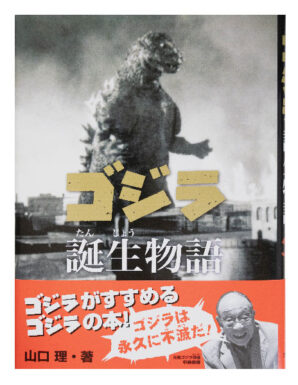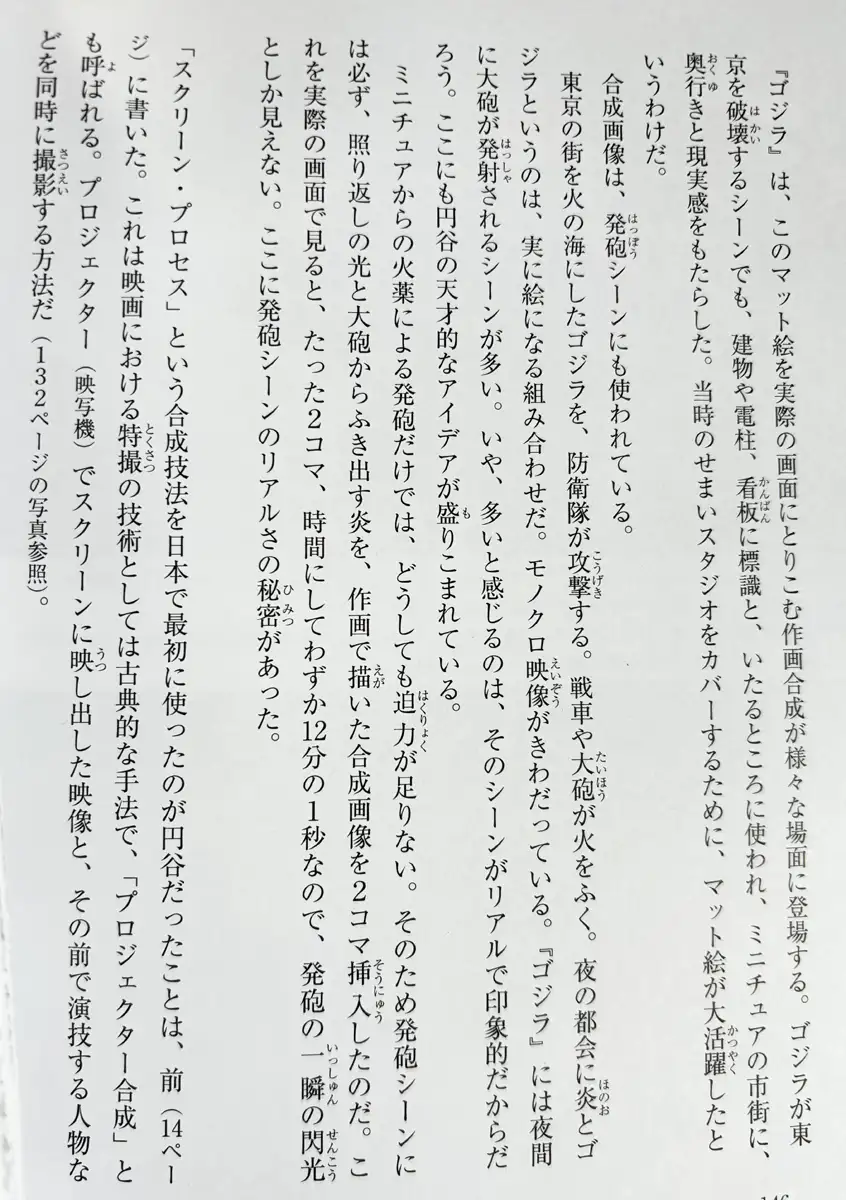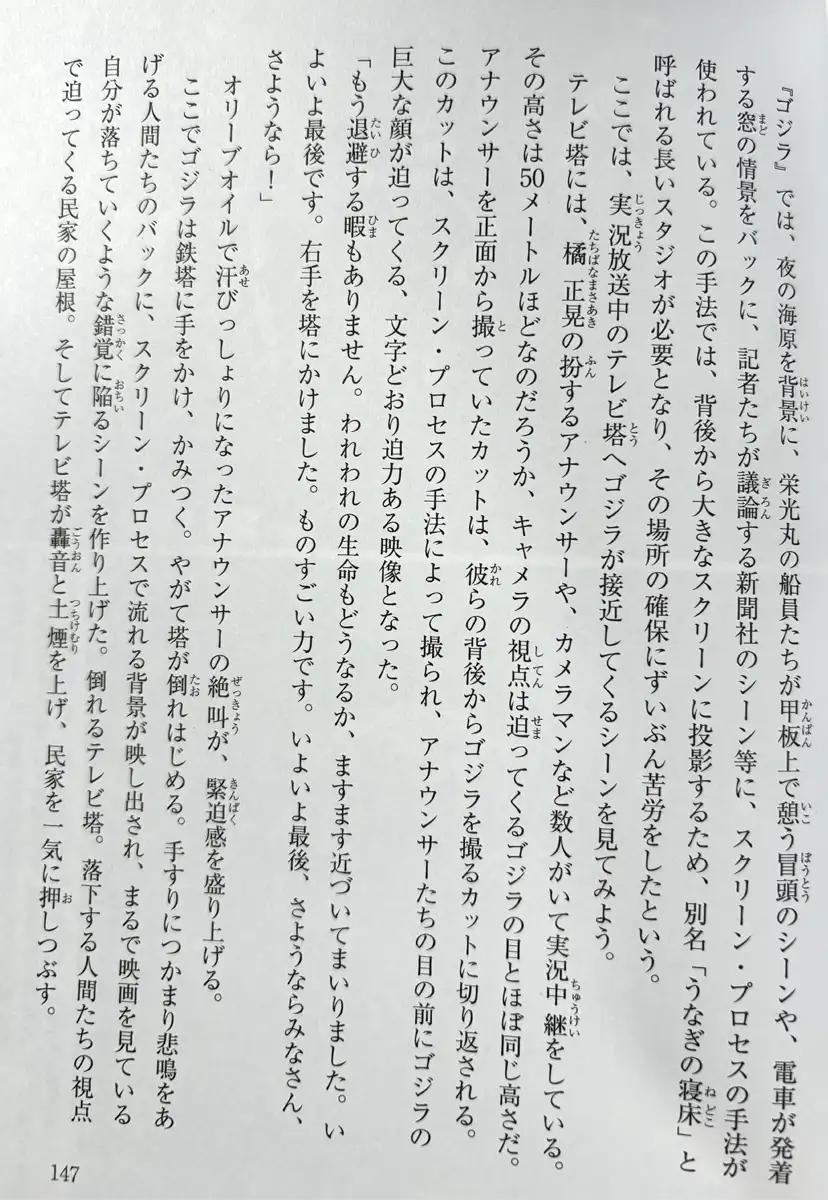4.30.2024
The Story of Godzilla’s Birth – Pt 66


P 146
『ゴジラ』は、このマット絵を実際の画面にとりこむ作画合成が様々な場面に登場する。ゴジラが東京を破壊するシーンでも、建物や電柱、看板に標識と、いたるところに使われ、ミニチュアの市街に、奥行きと現実感をもたらした。当時のせまいスタジオをカバーするために、マット絵が大活躍したというわけだ。
In “Godzilla,” animation synthesis, which incorporates this matte image onto the actual screen, appears in various scenes. Even in the scene where Godzilla destroys Tokyo, they were used everywhere, on buildings, telephone poles, and billboards, bringing depth and realism to the miniature city. Matte paintings were very popular in order to cover the small studios of the time.
合成画像は、発砲シーンにも使われている。
The composite image is also used in the shooting scene.
東京の街を火の海にしたゴジラを、防衛隊が攻撃する。戦車や大砲が火をふく。夜の都会に炎とゴジラというのは、実に絵になる組み合わせだ。モノクロ映像がきわだっている。『ゴジラ』には夜間に大砲が発射されるシーンが多い。いや、多いと感じるのは、そのシーンがリアルで印象的だからだろう。ここにも円谷の天才的なアイデアが盛りこまれている。
The defense forces attack Godzilla, who has turned the city of Tokyo into a sea of fire. Tanks and cannons catch fire. Fire and Godzilla in the city at night is a truly picturesque combination. The monochrome images stand out. There are many scenes in Godzilla where cannons are fired at night. No, the reason I feel like there are so many is probably because the scenes are realistic and impressive. Tsuburaya’s genius ideas are incorporated here as well.
ミニチュアからの火薬による発砲だけでは、どうしても迫力が足りない。そのため発砲シーンには必ず、照り返しの光と大砲からふき出す炎を、作画で描いた合成画像を2コマ挿入したのだ。これを実際の画面で見ると、たった2コマ、時間にしてわずか12分の1秒なので、発砲の一瞬の閃光としか見えない。ここに発砲シーンのリアルさの秘密があった。
Firing gunpowder from miniatures alone is not powerful enough. For this reason, in every firing scene, we inserted two composite images of the reflected light and the flames spewing out from the cannon. If you look at this on an actual screen, it’s only two frames, or 1/12th of a second, so it looks like nothing more than a momentary flash of gunfire. This was the secret to the realism of the shooting scene.
「スクリーン・プロセス」という合成技法を日本で最初に使ったのが円谷だったことは、前(14ページ)に書いた。これは映画における特撮の技術としては古典的な手法で、「プロジェクター合成」とも呼ばれる。プロジェクター(映写機)でスクリーンに映し出した映像と、その前で演技する人物などを同時に撮影する方法だ(132ページの写真参照)。
I wrote earlier (page 14) that Tsuburaya was the first person in Japan to use the compositing technique called “screen process.” This is a classic technique for special effects in movies, and is also called “projector compositing.” This is a method in which the image projected onto a screen by a projector and the person performing in front of it are simultaneously photographed (see photo on page 132).

P 147
『ゴジラ』では、夜の海原を背景に、栄光丸の船員たちが甲板上で憩う冒頭のシーンや、電車が発着する窓の情景をバックに、記者たちが議論する新聞社のシーン等に、スクリーン・プロセスの手法が使われている。この手法では、背後から大きなスクリーンに投影するため、別名「うなぎの寝床」と呼ばれる長いスタジオが必要となり、その場所の確保にずいぶん苦労をしたという。
In Godzilla, there is the opening scene where the sailors of the Eiko Maru are resting on the deck with the ocean at night in the background, and the scene in the newspaper office where reporters are having a discussion with the window of trains arriving and departing in the background. Screen process techniques are used. This method required a long studio, also known as the “eel bed,” as it was projected onto a large screen from behind, and it was said that it was quite difficult to secure such space.
ここでは、実況放送中のテレビ塔へゴジラが接近してくるシーンを見てみよう。
Here, let’s take a look at the scene in which Godzilla approaches the TV tower during a live broadcast.
テレビ塔には、橘正晃の扮するアナウンサーや、カメラマンなど数人がいて実況中継をしている。その高さは50メートルほどなのだろうか、キャメラの視点は追ってくるゴジラの目とほぼ同じ高さだ。アナウンサーを正面から撮っていたカットは、彼らの背後からゴジラを撮るカットに切り返される。このカットは、スクリーン・プロセスの手法によって撮られ、アナウンサーたちの目の前にゴジラの巨大な顔が迫ってくる、文字どおり迫力ある映像となった。
There are several people at the TV tower, including an announcer played by Masaaki Tachibana and a cameraman, who are providing live broadcasts. It’s probably about 50 meters high, and the camera’s viewpoint is almost at the same height as Godzilla’s eyes. The cut that shows the announcer from the front cuts back to a cut that shows Godzilla from behind them. This cut was filmed using the screen process method, and was literally a powerful image with Godzilla’s gigantic face looming right in front of the announcers.
「もう退避する暇もありません。われわれの生命もどうなるか、ますます近づいてまいりました。いよいよ最後です。右手を塔にかけました。ものすごい力です。いよいよ最後、さようならみなさん、さようなら!」
“We don’t have time to evacuate anymore. We are getting closer and closer to the fate of our lives. It’s finally the end. I put my right hand on the tower. It’s a tremendous force. It’s the end, goodbye everyone, goodbye!”
オリーブオイルで汗びっしょりになったアナウンサーの絶叫が、緊迫感を盛り上げる。
The screams of the announcer, drenched in olive oil, add to the tension.
ここでゴジラは鉄塔に手をかけ、かみつく。やがて塔が倒れはじめる。手すりにつかまり悲鳴をあげる人間たちのバックに、スクリーン・プロセスで流れる背景が映し出され、まるで映画を見ている自分が落ちていくような錯覚に陥るシーンを作り上げた。陥るシーンを作り上げた。倒れるテレビ塔。落下する人間たちの視点で迫ってくる民家の屋根。そしてテレビ塔が轟音と土煙を上げ、民家を一気に押しつぶす。
At this point, Godzilla puts his hand on the steel tower and bites it. Eventually, the tower begins to collapse. The background that was played by the screen process was projected onto the background of the people screaming as they held on to the railings, creating a scene where you would feel as if you were watching a movie and were falling. He created a scene where he would fall. A collapsing TV tower. The roof of a private house approaches from the perspective of falling humans. Then, the TV tower emitted a roaring sound and a cloud of dust, crushing private houses all at once.